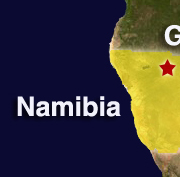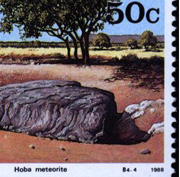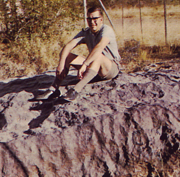Official Name:
Hoba is known by other names too, such as Hoba West and Grootfontein.
Location:
On a farm named Hoba West, 20 kilometres west of the village of Grootfontein, Namibia, in southwest Africa.

Enlargement
Location of the village of Grootfontein, Namibia, Africa. |
|

Enlargement
In 1988, South West Africa (now Namibia) issued a series of stamps portraying famous national sites including that of the Hoba meteorite. |
|
Fall or Find:
Find
Date:
The meteorite was discovered in 1920, but it fell many thousands of years earlier.
Mass Recovered:
The meteorite has never been officially weighed, but its mass has been estimated from its dimensions. It weighs approximately 60 metric tons. It is the largest meteorite fragment in the world!
Number of Fragments:
The one fragment still lies at the impact site. The meteorite measures 2.75 by 2.75 by 1 metre. It has an unusual, almost rectangular, shape.
Crater:
The meteorite lies in a 1.5-metre deep depression. The meteoroid slowed down as it passed through Earth's atmosphere, and the impact was not too violent. Nevertheless, the impact cavity was probably bigger and deeper than what can be seen today.
Circumstances:
Johannes Hermanus Brits discovered the meteorite while hunting on his farm.
History:
In March 1955, the meteorite was declared a national monument. The site where the Hoba meteorite lies was developed for tourists in the 1980s. Since then, a stone amphitheatre has been built around the meteorite to make it easier for visitors to look at it, and interpretation panels have been placed at the entrance to the site.
In 1988, a Namibian postal stamp was issued to commemorate the discovery of the Hoba meteorite.
Type:
Iron meteorite
Class:
Ataxite
Group:
IVB

Enlargement
Researcher J.D. Fernie traveled to the place where the Hoba meteorite was discovered. |
|
|
Composition:
Hoba contains 82% iron, and it is rich in nickel (16.5%). Its third most abundant element is cobalt (1%), and there are also traces of other elements, including iridium (27 parts per million), gallium (0.19 ppm), and germanium (0.05 ppm).
Scientific contribution:
The analysis of certain isotopes enabled scientists to determine how long it had been since the meteorite stopped being bombarded by cosmic rays. It appears that the Hoba meteorite has been lying on Earth for 30 000 to 80 000 years.
Over the years, a layer of oxidation formed on the surface of the meteorite. Scientists have studied this material to understand how iron meteorites deteriorate.
Comments:
Not all giant meteorites are placed in museums-Hoba, the largest ever discovered, is still lying in the open where it fell. Some museums have received a tiny fragment of it for analysis.
Part of the Planétarium's collection:
Yes